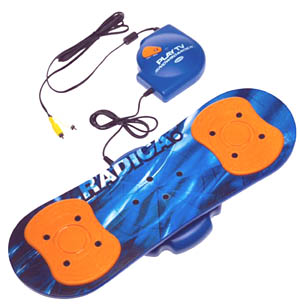Play TV Snowboarder
Interactive Game by Radica Games.
 Go in search for big air with Radica's Play TV Snowboard. Just connect the game to your TV or VCR. Get on your snowboard and start shreddin' the course. As you maneuver the snowboard, see the corresponding actions in full color and stereo sound on you TV screen. Choose from 4 exciting games. Free Ride/Trick Run, Timed Slalom Competition, Half-Pipe Trick Competition and Big-Air Competition. Compete for time and style points. If you want to win, avoid the obstacles and collect special power balls to increase your speed. In a very short period of time snowboarding has become as popular as skiing among winter sports enthusiasts. But while it can be a heck of a lot of fun, it's not exactly forgiving to novices. Fortunately, this living room version affords all the pleasure of boarding without any of the bruises or broken bones. The plastic board, which can hold up to 180 pounds, hooks up quite easily to any common TV. Once on board, riders can select one of four modes: half-pipe, slalom, big air, or freestyle. All selections are made using the board itself, and we found the interface to be a bit cumbersome at first. But once we got the hang of it, we were boarding our way down countless ski slopes and having a great time. While the graphics are not up to the quality of an Xbox game, playing a game while riding on an actual board is a hoot.
Go in search for big air with Radica's Play TV Snowboard. Just connect the game to your TV or VCR. Get on your snowboard and start shreddin' the course. As you maneuver the snowboard, see the corresponding actions in full color and stereo sound on you TV screen. Choose from 4 exciting games. Free Ride/Trick Run, Timed Slalom Competition, Half-Pipe Trick Competition and Big-Air Competition. Compete for time and style points. If you want to win, avoid the obstacles and collect special power balls to increase your speed. In a very short period of time snowboarding has become as popular as skiing among winter sports enthusiasts. But while it can be a heck of a lot of fun, it's not exactly forgiving to novices. Fortunately, this living room version affords all the pleasure of boarding without any of the bruises or broken bones. The plastic board, which can hold up to 180 pounds, hooks up quite easily to any common TV. Once on board, riders can select one of four modes: half-pipe, slalom, big air, or freestyle. All selections are made using the board itself, and we found the interface to be a bit cumbersome at first. But once we got the hang of it, we were boarding our way down countless ski slopes and having a great time. While the graphics are not up to the quality of an Xbox game, playing a game while riding on an actual board is a hoot.
History of Snowboarding
The history of snowboarding is a fascinating journey that takes us back to the 1960s, when pioneers like Sherman Poppen created the "Snurfer," a rudimentary board designed for snowy slopes. The Snurfer was essentially two skis strapped together and offered a more surf-like experience on snow. Although primitive, it laid the foundation for what would become a global phenomenon.
By the 1970s, innovators like Jake Burton Carpenter and Tom Sims started experimenting with board designs and bindings, making snowboarding more similar to skateboarding and surfing. Burton, in particular, played a crucial role in popularizing the sport by creating Burton Snowboards, one of the first companies exclusively dedicated to snowboarding gear. Throughout the late '70s and '80s, snowboarding started gaining traction, but not without facing resistance from ski resorts, many of which initially banned the activity.
The sport really started to boom in the late '80s and early '90s when it began to receive mainstream attention. The first snowboarding World Championship took place in 1983, and by 1998, the sport had earned a spot in the Winter Olympics, held in Nagano, Japan. Since then, snowboarding has grown in popularity and technical complexity, giving rise to various styles like freestyle, freeride, and alpine snowboarding.
Today, snowboarding is not only a professional sport but also a popular recreational activity, enjoyed by millions of enthusiasts worldwide. The advancement in gear technology, training methods, and the inclusion in high-profile sporting events have solidified its status as a mainstream winter sport. Its counter-culture roots still play a big role in the sport's identity, but snowboarding has undoubtedly entered the global stage, continually pushing boundaries both in athletic achievement and in broadening its appeal.
